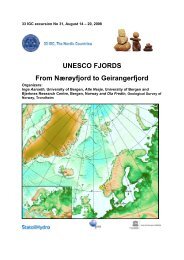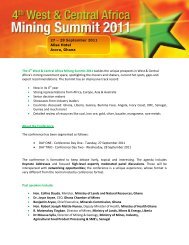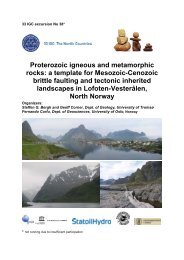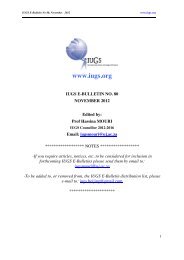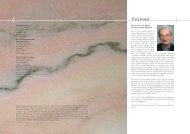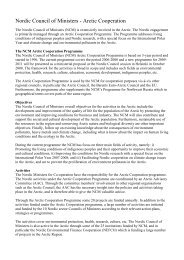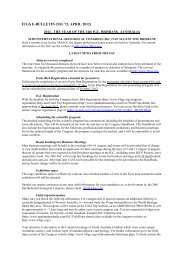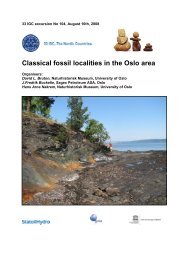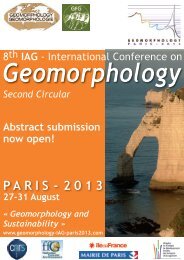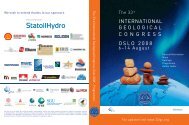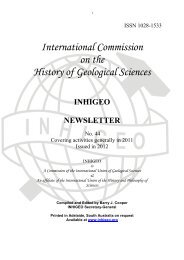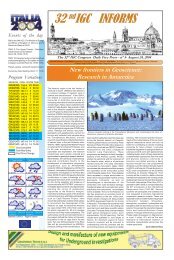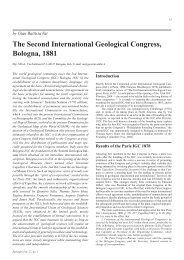Create successful ePaper yourself
Turn your PDF publications into a flip-book with our unique Google optimized e-Paper software.
Mikulinian (Eemian) Interglacial Horizon (QBIIIBmk, MIS 5e)<br />
The Mikulinian (Eemian) Interglacial sediments are revealed in the peripheral parts of the<br />
Kola Peninsula and confined to the valleys of the rivers in the southern, eastern and northeastern<br />
coast. In the central part of the region, the sediments of the Mikulinian Interglacial<br />
were found only in one place.<br />
The marine sediments of that time in the Kola region are known as the Ponoi beds (mIIIpn) in<br />
Russian scientific publications. This unit, which is composed of compact clays, loams, sandy<br />
loams, and fine-grained sands of the littoral and sublittoral zones, crops out in the lower parts<br />
of the examined sections along the Varzuga, Strel'na, Chapoma, Ponoi, Kachkovka rivers, and<br />
at the front part of the Svyatoj Nos Bay. Paleoecological reconstructions (Lavrova, 1960,<br />
Grave et al., 1969, Gudina, Yevzerov, 1981) demonstrate that the sea basin, where these<br />
sediments accumulated, was characterized by a more favorable environment as compared<br />
with the modern one. The water salinity was close to the normal one, and its temperature was<br />
higher than that of the present-day White Sea, which is typical of the first optimum of the<br />
Mikulinian (Eemian) Interglacial and correlated presently with oxygen isotope substage<br />
(OISS) 5e. All the data unambiguously indicate the Mikulinian age of the Ponoi Beds, which<br />
accumulated during the Boreal transgression. The upper sea limit reached near 150 m a.s.l. at<br />
the time of a climatic optimum. The sea occupied a considerable area within the continent.<br />
The Barents Sea and the White Sea were connected by numerous straits. The Atlantic warm<br />
waters freely penetrated into the White Sea, where the boreal and boreal-lusitanian species of<br />
marine organisms started to extend.<br />
The ESR/OSL-age of the Ponoi Beds ranges from approximately 120--130 to 100--105 ka<br />
(Korsakova et al., 2004).<br />
The lacustrine and peat interglacial sediments are confined to the depressions of the basement<br />
relief in the stable tectonic areas of the central part of the Kola region. They were found on<br />
the northern slopes of the Lovozero Tundras.<br />
Most of the interglacial sections are confined to the areas of weak tectonic activity typical of<br />
the eastern Baltic Shield. The present-day absolute elevation of the roof varies from several<br />
meters up to 140 -150 m a.s.l. for the marine interglacial deposits, and reaches 210 m a.s.l. for<br />
the continental interglacial deposits.<br />
Podporozh'e (Early-Middle Weichselian) Glacial Horizon (QBIIIBpd, MIS 5d<br />
– MIS 4)<br />
The Podporozh'e horizon is credibly dated. Its position in the regional stratigraphy, the timing<br />
and the geological volume are still disputable (Semjonova, 1998, Yevzerov, Nikolaeva, 2000,<br />
Korsakova et al., 2004). At present the Podporozh'e horizon combines marine (mIIIst), glacial<br />
(gIIIpd), glaciomarine (gmIIIpd), glaciofluvial (fIIIpd), glaciolacustrine (lIIIpd) sediments of<br />
the Early-Middle Valdaian (Early-Middle Weichselian) age.<br />
The marine deposits (in Russian scientific publications known as the Strel'na beds (mIIIst))<br />
are mainly represented by marine and subsaline sediments of the up to 30-35 m thick littoral<br />
and sublittoral zones. Strel'na beds are composed of loams and sandy loams with mollusk<br />
shells, pebbles, boulders, and of fine- to medium-grained sands with lenses of coarse-grained<br />
varieties. The bedding conditions and structural--textural features of these marine sequences,<br />
6



